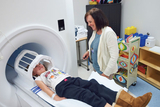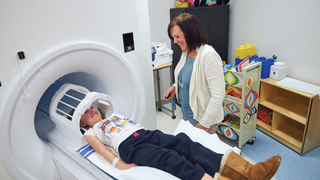
Magnetic resonance imaging (MRI) is a powerful imaging modality with many advantages in evaluating children. While avoiding the potential risks of radiation associated with computed tomography (CT), today’s MRI technology provides excellent spatial resolution and tissue contrast for evaluating every part of the body. The team of imaging specialists at Children’s Hospital of Philadelphia have extensive experience in performing and interpreting MRI examinations and use the most up-to-date and innovative imaging technology and protocols tailored specifically for imaging children.
In addition to risks associated with the magnet, some study indications require the use of intravenous contrast material, which is gadolinium-based for MRI. As reported in the literature, the incidence of adverse reactions to these contrast agents is incredibly rare, especially with the newer-generation agents used at CHOP. A history of adverse reactions to other contrast media, most commonly reported with those used for CT, does not preclude administration of MRI contrast nor does it necessitate pre-medication prior to injection.

In addition to standard MRI and contrast agent safety concerns, when considering MRI for your patient, attention should be given to the length of time required for image acquisition. A typical MRI examination lasts 45 to 60 minutes with additional time required for preparation and localization. MRI images are severely degraded by motion; therefore, patients who are unable to hold still for that amount of time may require sedation or anesthesia to obtain diagnostic images. The medications and/or interventions required for this process carry their own set of risks, which are explained in detail to patients and families by our sedation services team. These risks should be weighed against the benefits of MRI when ordering the examination.
Other than the scan time, primary patient complaints include the narrowness of the magnet bore and the noise associated with image acquisition, which is worse with particular sequences. Therefore, nonsedated patients who have difficulty with small spaces and/or loud noises, may have trouble tolerating the entire examination. The most common example is some children with autism spectrum disorder. Our MRI technologists and child life specialists are experienced in helping children overcome any fears associated with the examination (see "Taking the Fear out of an MRI").
Ultimately, while MRI offers extensive benefits and has relatively few safety risks, it may not be the optimal modality to evaluate your clinical concern. CHOP’s team of radiologists and imaging specialists are happy to discuss the appropriate imaging test for your patient on a case-by-case basis and guide you through the complex ordering system.
Featured in this article
Specialties & Programs
Magnetic resonance imaging (MRI) is a powerful imaging modality with many advantages in evaluating children. While avoiding the potential risks of radiation associated with computed tomography (CT), today’s MRI technology provides excellent spatial resolution and tissue contrast for evaluating every part of the body. The team of imaging specialists at Children’s Hospital of Philadelphia have extensive experience in performing and interpreting MRI examinations and use the most up-to-date and innovative imaging technology and protocols tailored specifically for imaging children.
In addition to risks associated with the magnet, some study indications require the use of intravenous contrast material, which is gadolinium-based for MRI. As reported in the literature, the incidence of adverse reactions to these contrast agents is incredibly rare, especially with the newer-generation agents used at CHOP. A history of adverse reactions to other contrast media, most commonly reported with those used for CT, does not preclude administration of MRI contrast nor does it necessitate pre-medication prior to injection.

In addition to standard MRI and contrast agent safety concerns, when considering MRI for your patient, attention should be given to the length of time required for image acquisition. A typical MRI examination lasts 45 to 60 minutes with additional time required for preparation and localization. MRI images are severely degraded by motion; therefore, patients who are unable to hold still for that amount of time may require sedation or anesthesia to obtain diagnostic images. The medications and/or interventions required for this process carry their own set of risks, which are explained in detail to patients and families by our sedation services team. These risks should be weighed against the benefits of MRI when ordering the examination.
Other than the scan time, primary patient complaints include the narrowness of the magnet bore and the noise associated with image acquisition, which is worse with particular sequences. Therefore, nonsedated patients who have difficulty with small spaces and/or loud noises, may have trouble tolerating the entire examination. The most common example is some children with autism spectrum disorder. Our MRI technologists and child life specialists are experienced in helping children overcome any fears associated with the examination (see "Taking the Fear out of an MRI").
Ultimately, while MRI offers extensive benefits and has relatively few safety risks, it may not be the optimal modality to evaluate your clinical concern. CHOP’s team of radiologists and imaging specialists are happy to discuss the appropriate imaging test for your patient on a case-by-case basis and guide you through the complex ordering system.
Contact us
Department of Radiology